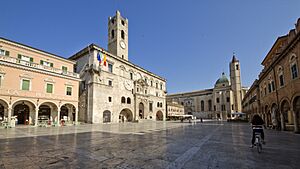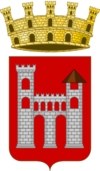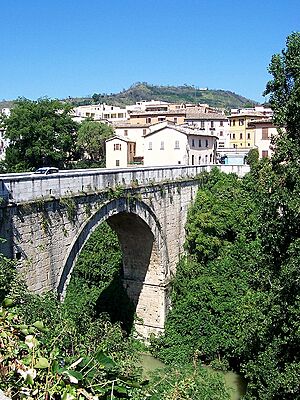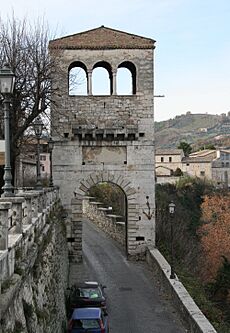Ascoli Piceno facts for kids
Quick facts for kids
Città di Ascoli Piceno
|
|||
|---|---|---|---|

Piazza del Popolo
|
|||
|
|||
| Country | Italy | ||
| Region | Marche | ||
| Province | Ascoli Piceno (AP) | ||
| Frazioni | see list | ||
| Area | |||
| • Total | 160 km2 (60 sq mi) | ||
| Elevation | 154 m (505 ft) | ||
| Population | |||
| • Total | 45,483 | ||
| • Density | 284/km2 (736/sq mi) | ||
| Demonym(s) | Ascolani | ||
| Time zone | UTC+1 (CET) | ||
| • Summer (DST) | UTC+2 (CEST) | ||
| Patron saint | St. Emygdius | ||
| Saint day | 5 August | ||
Ascoli Piceno is a historic city in the Marche region of Italy. It is the capital of the province of Ascoli Piceno. The city is famous for its beautiful buildings made from a special local stone called travertine.
Contents
Exploring Ascoli Piceno's Location
Ascoli Piceno is located where two rivers meet: the River Tronto and the smaller River Castellano. Mountains surround the city on three sides.
Two large national parks are close by:
- The Parco Nazionale dei Monti Sibillini is to the northwest.
- The Parco Nazionale dei Monti della Laga is to the south.
The city has good connections to the Adriatic coast by train. You can also reach Rome by a main road called the Salaria.
A Look Back at Ascoli Piceno's History
Ascoli Piceno, originally called Ausculum, was founded by an ancient Italian group called the Piceni. It was first a city of the Sabines.
Becoming Part of the Roman World
After a defeat by the Romans in 268 BC, Ascoli became a "federated" city. This meant it had some independence but was connected to Rome. The important Via Salaria (salt road) later linked Ascoli to Rome. This road was used to transport salt from the Adriatic coast.
The Social War and Roman Rule
In 90 BC, Ascoli was the first Italian city to rebel against Rome during the Social War. People in the city had felt unfairly treated by Rome for a long time. The city was surrounded and captured by Roman forces. Archeologists have found sling bullets, showing that many Roman soldiers, including those from Gaul and Spain, were part of the attack. After the war, Ascoli became a Roman municipium (a self-governing town) and later a colonia (a Roman settlement).
Through the Middle Ages
During the Middle Ages, different groups attacked Ascoli. First came the Ostrogoths, then the Lombards. For almost 200 years, it was part of the Lombard Duchy of Spoleto. Later, the Franks ruled, but local bishops became very powerful in the city.
In 1189, Ascoli became a free city with its own government. However, disagreements among its citizens led to problems and made the city weaker. This allowed powerful leaders from outside, like Galeotto I Malatesta and Francesco I Sforza, to take control for a while.
Eventually, in 1482, Francesco Sforza was forced out. Ascoli then became part of the Papal States, which were lands ruled by the Pope. In 1860, Ascoli joined the newly unified Kingdom of Italy.
Main Sights: What to See in Ascoli Piceno
Many of the old buildings in Ascoli Piceno are made from a local stone called travertine.
The city has two important squares:
- Piazza del Popolo is a beautiful Renaissance square.
- Piazza Arringo was once the main center for government and religion. It is surrounded by the Cathedral, the baptistery, the Bishop's residence, and the Palace of the Commune.
In the Middle Ages, Ascoli Piceno was said to have around 200 towers! Today, you can still see about 50 of them.
Churches and Convents
- Cathedral of Sant'Emidio: This large church is dedicated to Saint Emygdius. It has a famous painting by Carlo Crivelli.
- San Francesco: This church was started in 1258 and has a Gothic style. Next to it is the Loggia dei Mercanti, a beautiful building from the 1500s.
- Convent of San Francesco: This old convent next to the church was once an important learning center.
- Sant'Agostino: A 14th-century church. Its convent now holds the town library and an art gallery.
- San Pietro Martire: A 13th-century church that holds a special container with a piece of the Holy Thorn.
- San Tommaso: This church from 1069 was built using stones from a nearby Roman amphitheater.
Secular Buildings (Non-Religious)
- Roman Bridges: The city has several ancient Roman bridges, including the Ponte del Gran Caso, Solestà Bridge, and Ponte di Cecco over the Castellano River.
- Roman Walls: You can see parts of the old Roman walls, like those of the "Fortezza Pia".
- Palazzo dei Capitani del Popolo: This palace was built in the 13th century and was once the seat of local leaders.
- Palazzo dell'Arengo: Located near the Cathedral, this is another important historic palace.
- Porta Gemina ('Twin Gate'): An ancient Roman gate from the 1st century BC. The Via Salaria used to enter the city through this gate.
- Porta Tufilla: A tower-like gate built in the 1500s, connected to a medieval bridge over the River Tronto.
- Fortezza Pia: A fortress rebuilt in 1560 by Pope Pius IV.
- Malatesta Fortress: This fortress was used as a jail until 1978.
- Grotte dell'Annunziata ('Grottoes of the Annunciation'): A large ancient Roman structure with many niches. Its original purpose is still a mystery.
Not far from the city, in Castel Trosino, a rare 6th-century Lombard burial ground was discovered in 1893.
Parks and Gardens
- Giardino Botanico, Istituto Tecnico Agrario Statale "Celso Ulpiani": This is a botanical garden where you can see many different types of plants.
Economy and Transport
Ascoli Piceno has some Italian and international companies, but most of its economy comes from small and medium-sized businesses. Farming is still important, with crops like wheat, olives, and fruits.
The Ascoli Piceno railway station connects the city to the coast.
Education
The city is home to a School of Architecture and Design, part of the University of Camerino. It also hosts the International School on Safety and Environmental Protection, a private university.
Culture and Sport
The Quintana Festival
The main festival in Ascoli Piceno happens on the first Sunday in August. It's a historical parade with over 1500 people dressed in amazing Renaissance costumes. This celebration honors Saint Emidio, the city's protector.
After the parade, there's a tournament called the Quintana. Six knights, each representing a different neighborhood, ride their horses and try to hit a target (an effigy of an Arab warrior). The knight who shows the most strength and skill wins the palio, which is the grand prize.
Sports
The River Castellano is a popular spot for swimming in the summer.
Ascoli Calcio is the city's main football (soccer) team. Founded in 1898, it's one of Italy's oldest teams and has played many years in the top league, Serie A.
Gastronomy (Food)
Olive all'ascolana is a famous dish that comes from Ascoli Piceno. It's made from olives that are stuffed, breaded, and fried. They are a delicious local specialty!
People from Ascoli Piceno
- Cecco d'Ascoli: A poet from the 12th century.
- Carlo Crivelli: A famous Renaissance painter.
- Mattia Destro: A well-known footballer.
- Alice Pagani: An actress, model, and author.
International Connections
Ascoli Piceno is a sister city with:
 Trier, Germany (since 1958)
Trier, Germany (since 1958) Massy, France (since 1997)
Massy, France (since 1997) Banská Bystrica, Slovakia (since 1998)
Banská Bystrica, Slovakia (since 1998)
See also
 In Spanish: Ascoli Piceno para niños
In Spanish: Ascoli Piceno para niños
Images for kids











